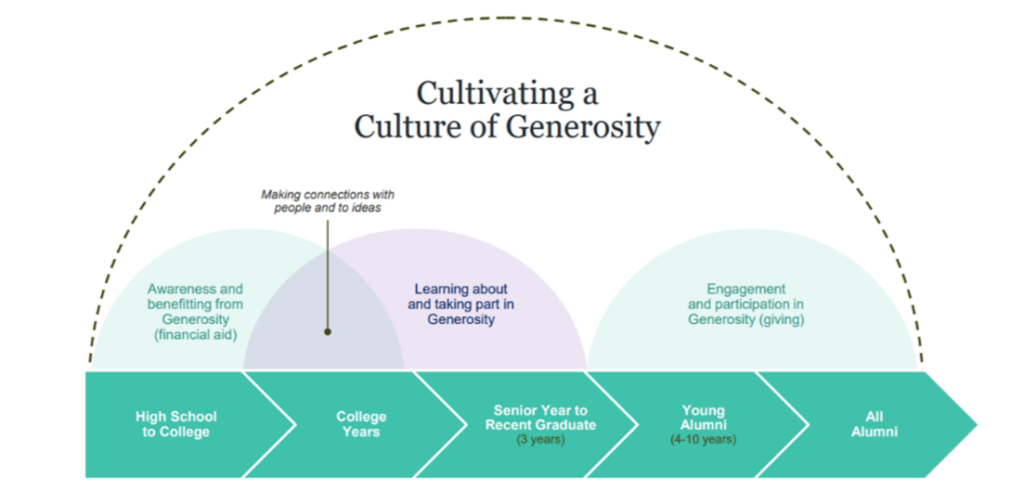The Challenge: Declining Alumni Participation
It’s a common concern across university halls and boardrooms: alumni giving is on the decline. Nationally, participation has been trending downward for more than a decade. The effect is most pronounced when looking at young alumni. Public universities, private institutions, community and technical colleges—all classifications have felt the effects.
Recently Kenyon College, an institution long recognized as a hub for innovation and critical thinking, sought to explore—and address—this challenge.
About Kenyon College
- Founded in 1824, Kenyon College is the oldest private college in Ohio.
- Kenyon College has graduated Rhodes Scholars, Fulbright Fellows, a President of the United States, a U.S. Supreme Court Justice, Oscar and Pulitzer winners, and many other notable figures.
- Home to one of the nation’s most respected literary magazines, The Kenyon Review, the College is known for its focus on exemplary writing and critical thinking.
- The College is credited with developing the model of professors serving as academic advisors, a practice now widely adopted.
As Colleen Garland, Vice President for Advancement, reflected: “What we’ve been seeing here and nationwide can be compared to a tale of two cities. On one hand, donors are giving more generously than ever before, and colleges like ours are raising more money than ever. But at the same time, more people are sitting on the sidelines. We wanted to understand this more deeply, so our team could better sustain the deep bonds formed on our campus and ensure a sustainable future for Kenyon College in the years to come.”
Kenyon College partnered with Benefactor Group on The Generosity Project: an initiative designed to uncover the causes of Kenyon College’s declining alumni participation and develop a multi-year strategy for increasing campus-wide generosity.
“We chose to work with Benefactor Group for several reasons,” shared Colleen. “Their team has deep thinkers and industry leaders. And, because they work both inside and outside of higher education, their finger is on the pulse of creative and cutting-edge things happening across different industries.”
Of the many learnings that occurred throughout the Generosity Project, four stood out.
1. Generosity must be infused into every stage of the student-to-alumni journey.
As Colleen summarized, “What began as an alumni generosity project quickly became a campus generosity project. Benefactor Group helped us affirm that, for a true culture of philanthropy to flourish, generosity must be manifest across all stages of the student and alumni experience.” In short, philanthropy begins early; it grows over many years. By making adjustments that impact all phases of an individual’s journey—their high school years, college experience, time as a recent graduate, and alumni years—Kenyon College is poised to reap greater benefits, financial and cultural.
2. Treat your faculty and administrators like donors—invite them to be partners for transformation.
Consider the “a-ha” moment that occurs when fundraisers or volunteers realize that donors receive joy from giving. Asking for a gift becomes a more positive experience; volunteers and fundraisers feel eager and empowered to reach out. The same can be true when inviting faculty, staff, and administrative leadership to participate in fundraising. Treat these individuals as partners. Share with them the impact that will be possible with their support. As Colleen reflected, “Our faculty and staff were ready and willing to jump in and support this work. This may seem surprising—until you realize they’re responding to an invitation to be part of something bigger than themselves. It’s an invitation for transformation.”
3. Make the donor journey heroic.
At Kenyon College, this project helped to affirm the benefits of making donors the agents of change in communications, stories, and day-to-day language. It’s not: “when donors give to Kenyon, the College changes lives.” It’s: “donors change lives.”

4. Take implementation seriously—and step by step.
Benefactor Group often recommends an agile project approach when implementing a major plan. Begin by committing to the overall vision, then tackle it in 90-day “sprints.” Prioritize tactics, select a manageable number to address, determine near-term deadlines, and assign an owner for each. Check in frequently, learn as you go, then adjust and plan the next sprint. Kenyon College has taken this seriously and made accountability a priority. Implementation is overseen by a tri-chair Generosity Project Committee and supported by a dedicated project manager.
When asked about the impact of the project, Colleen shared two thoughts:
“First, I anticipate our work together will ensure donors and alumni feel connected to our College—and see the impact of their giving—long after they have graduated. And second, I believe that the impact of this project will be felt by students. I believe this will help students to see Kenyon College as a cause worthy of their generosity.”





